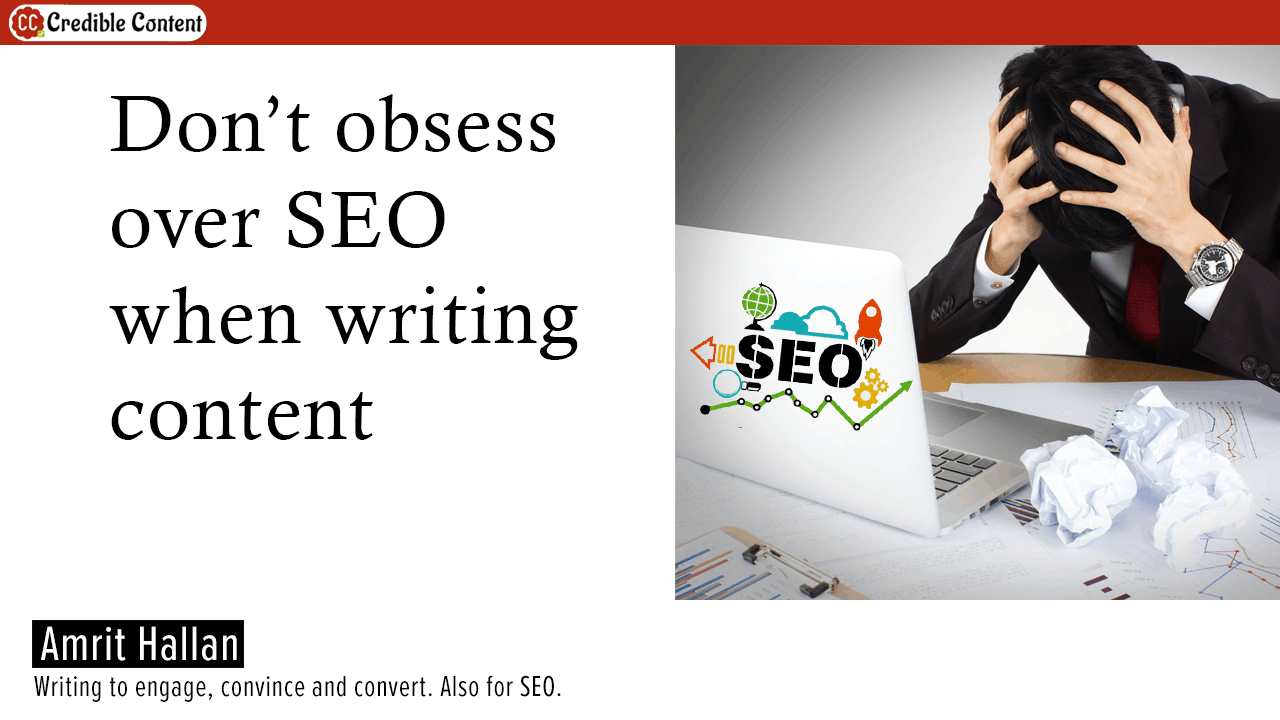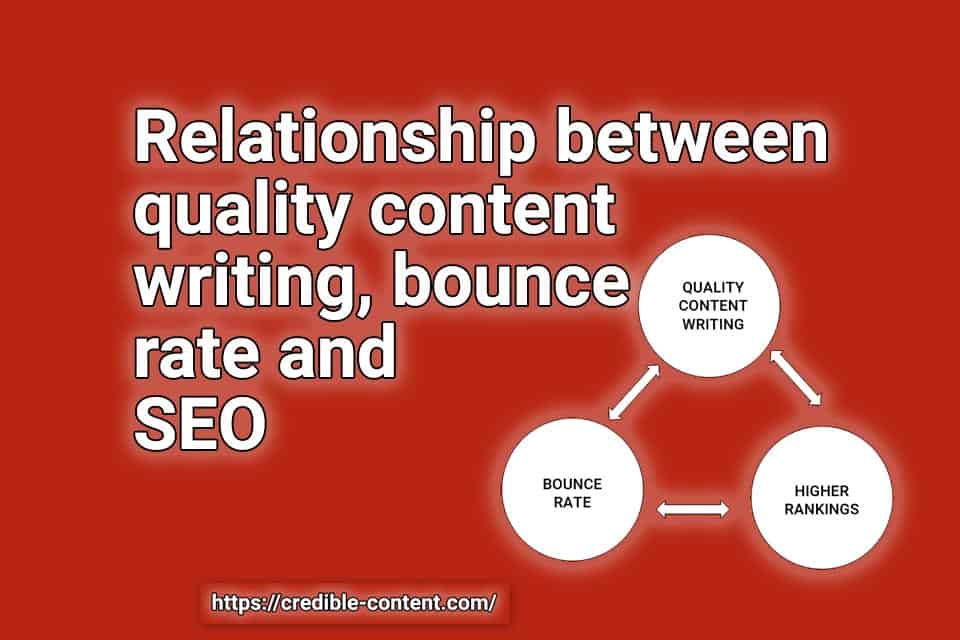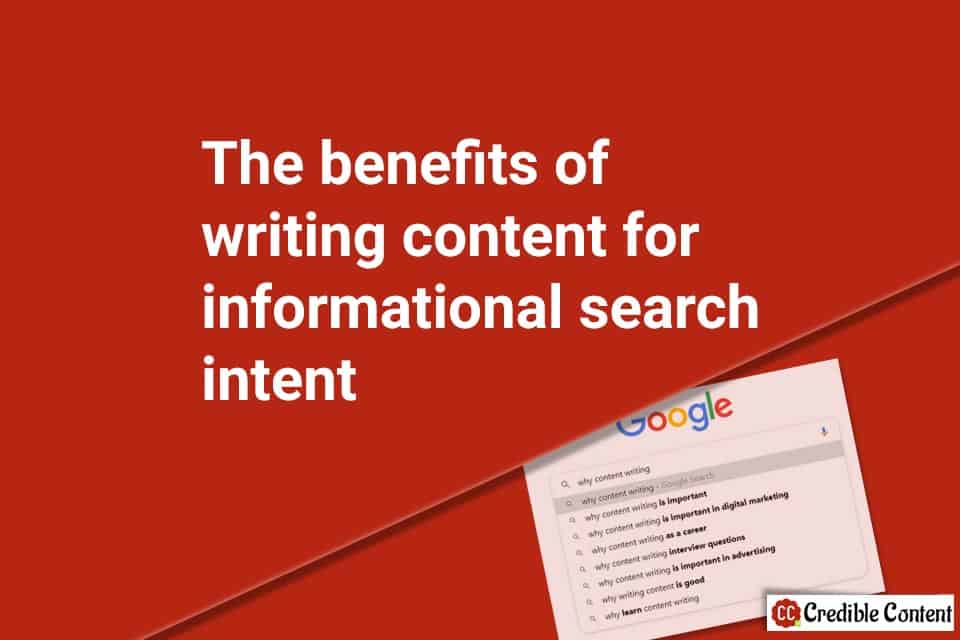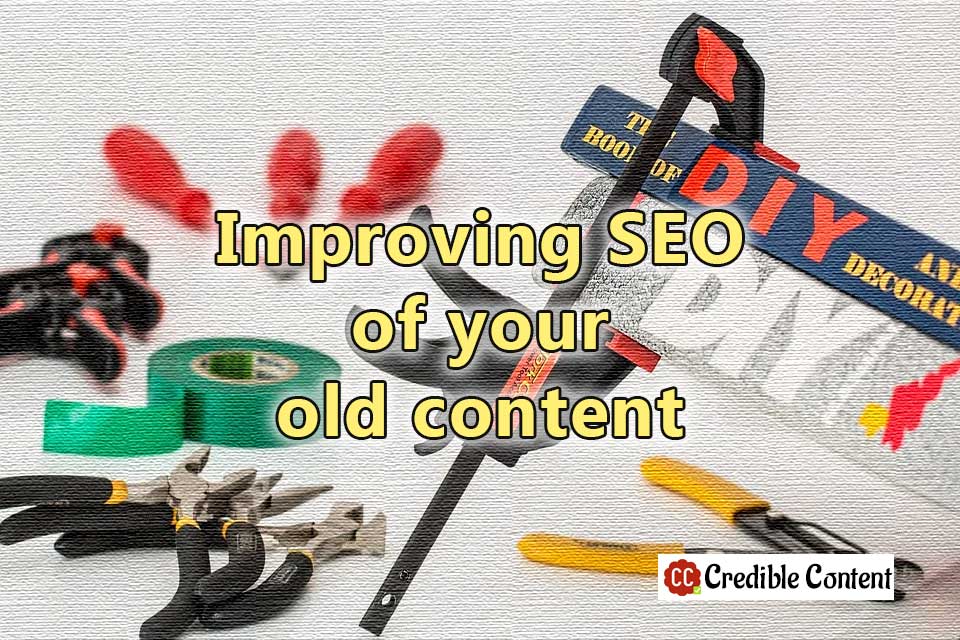
Improving SEO of your old content
In this blog post you are going to learn some ways you can use your old content – content that you have already published – to improve your SEO.
Main topics covered in this blog post
If search engine traffic matters to your business, you must always be thinking how to the improve search engine optimization of your website or blog. You constantly need to work on improving your search engine rankings. For that, often you add new content such as blog posts, web pages and articles.
Why fresh content is constantly needed for better search engine rankings? Why does fresh content improve SEO ranking?
You may like to read: Why it is important to publish fresh content regularly on your website.
There are multiple reasons. Whenever you buy something, you want the latest. The search engines want the same thing for their users. They want to provide them the latest possible information available on the topic they are searching for.
Even people want the latest information. When you want to learn about content marketing or digital marketing, do you want to read what people were doing back in 2014 or you want to know what people are doing in 2020?
Hence, this tendency — both in humans and machines — to constantly look for new content makes it necessary that you regularly add fresh content to your website or blog.
Although adding highly targeted fresh content is always a good and recommended strategy, do you know that you can also improve your search engine rankings by making changes to your existing content. Your old content can also help you improve your SEO.
In this post I’m going to discuss how.
How your old content is invaluable for your SEO
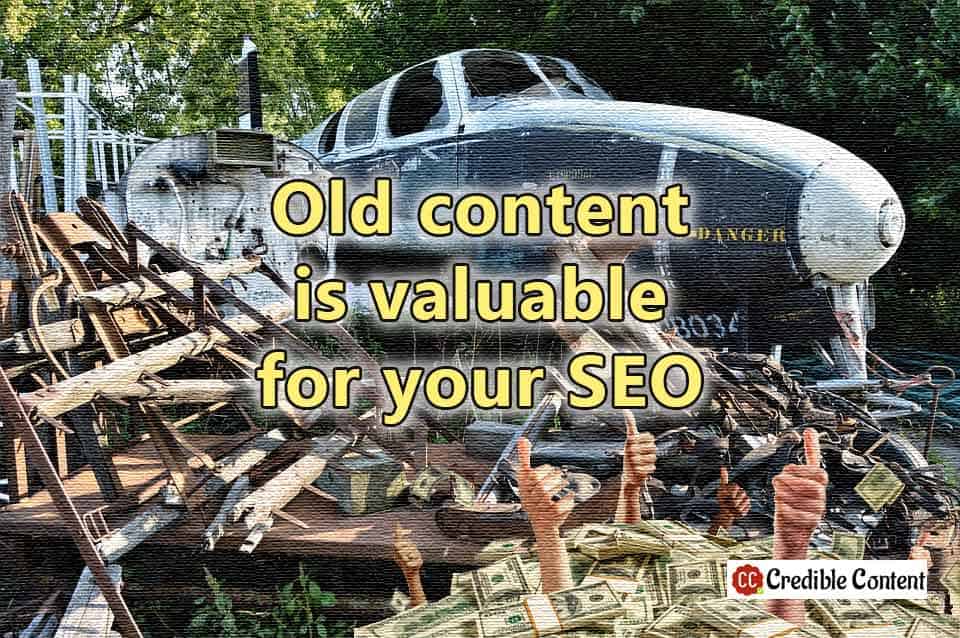
Old content is valuable for your SEO.
If you don’t want to spend money on writing and publishing fresh content on your website, you can increase as your ranking for free by improving the quality of your existing content.
Remember that whatever SEO you enjoy right now, it has been built on the foundation of your old content, your existing content.
If your website is a few years old and you have been regularly adding new content to your website, you already have a repository with you.
When you had just posted those blog posts and web pages, they may have enjoyed higher search engine rankings but as they got old and as the others published better versions or fresher versions, your high-ranking content got relegated to lower rankings during the proceeding months and years.
The problem sometimes is, you have already covered some important topics in your old content. If you want to write again on these topics, you may end up writing and publishing duplicate content.
Sure, the content will not be exactly similar, but you may have a similar headline or title and most of the information may already be existing in older blog posts and articles.
As a result, you feel bound and constraint. You want to improve rankings for those keywords but since you have already covered them in older blog posts, you do not want to take chances with newer blog posts.
You can be creative with the same ideas. I have multiple times written how you can re-purpose your old content and how you can rejuvenate it and I’m still writing this blog post.
Anyway, the point is, your old content is already indexed and ranked. All you have to do is, spruce it up with updated information, more data, better use of primary and secondary keywords and various other things.
Here are a few things you can do to improve your SEO using your old content:
Choose blog posts or web pages you want to improve for better SEO for chosen keywords
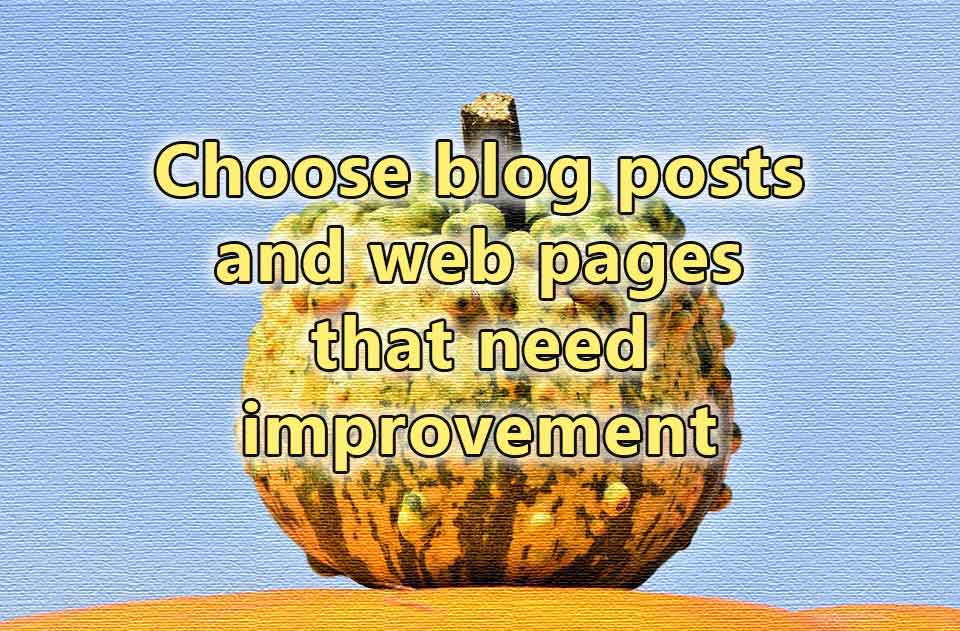
Choose blog posts and web pages that need improvements.
Which keyword rankings you want to improve? In which blog posts and web pages you have already covered those keywords?
If you use a content management system like WordPress you can easily search your existing posts and find out titles that match your keyword/keywords.
Quickly search on Google how they currently rank. If they are not ranking well, you can add them to an Excel sheet.
In case you’re using a tool like SEMRush you can quickly run your links through its system and find out what sort of content better ranking links are publishing.
Take note of the information, the number of words, the use of keywords in the title and other attributes of those links.
This will give you an idea of how to change your own web pages and blog posts.
As a less expensive alternative you can also use Serpstat that gives you more or less the same information but without overwhelming you with excessive data and overbearing expense.
Anyway, the point is knowing which pieces of your old content ranking are lower than they were ranking previously for your chosen keywords and what improvements are needed.
Add more content to thin content

Add more content to thin content for better SEO.
I’m not crazy about creating long pieces of blog posts and web pages just for the sake of improving SEO, but the size does matter if you’re not regular.
Have you added small blog posts and web pages (300-400 words) thinking that the sheer number would improve your SEO?
They may have given you the initial push and a false sense of security, but ultimately Google seems to prefer long form content, anywhere between 1500-3500 words.
You may like to read: Is longform content always better compared to shorter pieces?
Google aims to provide as much information as possible through a single link so that the user doesn’t have to waste lots of time hopping from one link to another.
If a user finds your link on Google, clicks it, comes to your website, goes through your content, and then comes back on Google and carries out the same search, Google assumes that she didn’t find what she was looking for.
It’s like, she has a problem, she is looking for a solution, Google suggested your link, she visited your link and since she carried out the same search Google assumes that its suggestion wasn’t appropriate and then uses this action to decide your ranking.
The more such incidents take place, the lower your rankings become.
Hence, for every keyword or title, put in as much information as possible.
Consider refurbishing of every piece of your old content as a full-fledged project. Don’t make it into a rush job.
Carry out a thorough auditing. Make note of where you can add new content. Research data. Organize your content in such a manner that your visitors can easily find the information they are looking for.
- Increase the length beyond 1500 words.
- Organize the text under headings and subheadings.
See if you can improve the title and the description
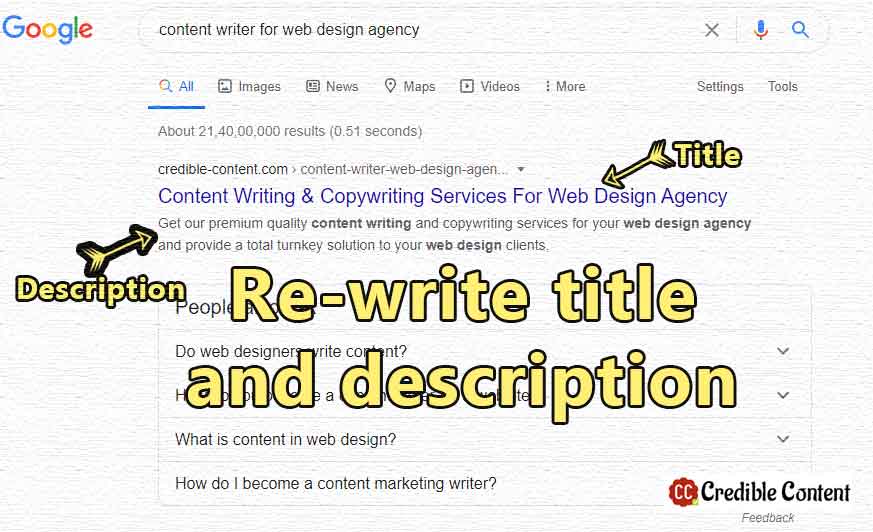
Re-write title and description of your old content.
Your title and description, the meta information, has a significant impact on your SEO. After all your title appears as a hyperlink in the search results and the hyperlink is followed by the description.
Data has shown that if the search term a user has just used appears in your title as hyperlink, she is more prone to clicking the link.
So, when you are modifying your old content, try to incorporate your main keyword into the title of your blog post or web page and also mention it once, with variations and alternative words, within the description.
Maybe initially you were not very SEO-savvy and you ignored this part of search engine optimization, but now you can make these improvements.
Use images under different sections and headlines

Use images for different sections and headings.
I have seen that this has a positive impact on your search engine rankings.
Creating quality images for different sections and headlines can be a time-consuming undertaking, but it is worth your time.
You can use the images to incorporate your keywords but make sure you don’t unnecessarily stuff your keywords otherwise it can have a negative effect on your SEO.
Images also improve your rankings in Google Images.
Use your main keywords within the top 100 words
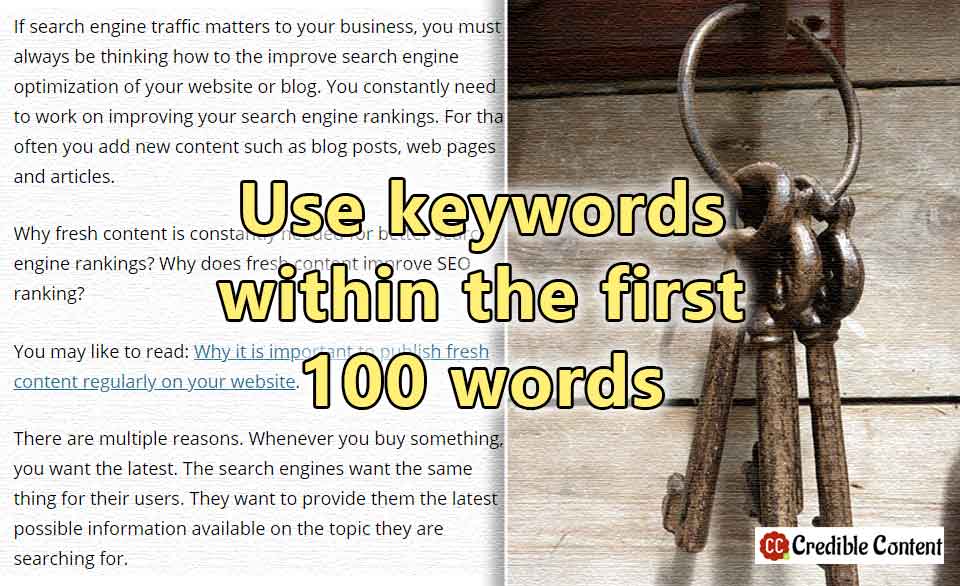
Use your keywords within the first 100 words.
There is a reason for that. It involves both humans and machines.
Humans are in a hurry. They want you to talk about the real thing as soon as possible. The real thing is contained within your keywords assuming your using appropriate keywords.
For example, in this blog post, I’m telling you how to use your old content to improve your SEO.
I have used words like “old content”, “improve SEO” and “search engine optimization” within the 100-word-bracket.
You don’t have to force it. In the beginning of every blog post or web page, just write a small intro of what you’re going to achieve through this blog post or web page. If you do that, you will be automatically covering your primary keywords.
When search engine crawlers crawl your content, sometimes they leave midway due to 100+ reasons. They draw conclusions about your content based on whatever information they were able to glean while partially crawling your content.
This way, if they have crawled even a single paragraph of your link, they will be gathering the relevant keywords from your content and using that information to rank your content.
Place your keywords strategically across the body text of your blog post or web page

Strategically use keywords across your body text.
Google can easily make out if you are using your keywords just to improve your SEO.
Hence, do not repeat unnecessarily. Spread your keywords over the entire length and breadth of your blog post or web page.
I follow two rules:
- Use your keywords every 150-200 words and not less.
- Use different variations of your keywords.
For example, I don’t always have to use SEO. I can use search engine optimization. I can use higher rankings. I can use ranking high. I can use better search results. I can use Google rankings. I can use top search results.
These are called LSI keywords – Latent Semantic Indexing.
They give Google an overall idea of what you are talking about in a diverse manner. The algorithm can draw meaning through contextually stringing together your words and sentences for better rankings.
Aim for Featured snippets optimization for better SEO

Example of Google featured snippet
Featured snippets are the highlighted, non-sponsored, search results you sometimes see at the top of the search results page.
This Search Engine Land blog post says that if your content gets shown in the Featured snippets section, there can be great SEO gains.
You may like to read: Google’s Featured Snippets: How to rank at #1 with strategic content writing.
The key is, providing the most appropriate answer to the question being asked by the Google user.
Use your keywords in headlines and bulleted lists

Use your keywords in headlines and bulleted lists.
It is important to use your keywords in the page elements that are used to quickly scan your content.
Search engine crawlers give great credence to your text contained within your headlines and bulleted lists.
By simply scanning through your headlines and bulleted lists, people must be able to get the gist of what you are trying to communicate.
Using this logic, search engine algorithms analyse your content based on the scannable elements of your web page or blog post – headlines and bulleted lists.
Improve the overall quality

Improve overall quality of old content to improve SEO.
You can add more links as references. If the existing images in these blog posts and web pages are very heavy, you can reduce their size.
In case there are some spelling mistakes you can take care of them. Think of all the ways you can improve the overall quality of your blog posts and web pages.
Make your content mobile friendly

Make your content mobile friendly.
Do you know Google ranks your content based on how it looks on mobile devices? If your content does not fit well on mobile devices, it loses its rankings.
You do not have to worry if you have a liquid layout, which means it easily fits on various screen sizes. If this is not the case, you seriously need to consider revamping your website layout.
People on mobile phones do not read long sentences and heavy paragraphs.
Use small paragraphs. Rarely go beyond two sentences in each paragraph.
Use smaller sentences. Smaller sentences are easier to interpret both for humans and search engine algorithms.
No matter how advanced AI gets, if you create overly complicated sentence structures, it becomes difficult for the algorithms to understand what you are trying to say.
Hence, mobile and user-friendly content means
- Use shorter sentences.
- Use shorter paragraphs – not more than two sentences.
- Keep a simple sentence structure.
- Don’t digress from your main topic.
- Don’t use ambiguous, confusing words just for fun sake.
Use your keywords in the last paragraph

Use keywords in the last paragraph.
Your last paragraph is like the last thoughts that people have after going through your blog post or web page.
You can sum up everything you have described in the blog post. This gives you an opportunity to use your keywords in the last paragraph.
Conclusion about using your old content to improve your rankings
In the race to continuously add fresh content sometimes we end up ignoring our old content, which can be a gold mine.
My experience also tells me that it is easier to revamp existing content than to come up with new content writing ideas.
You already have the material in front of you. In many cases all the needed thoughts are already there. The title is already there. All you have to do is, improve it.
In fact, before publishing your next, new blog post or web page, go through your existing content and make all possible improvements.

